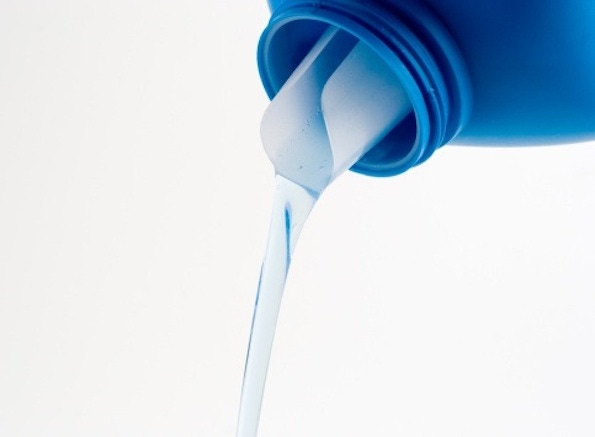Lori Alper, founder of Groovy Green Livin, shares how her Tide-reformulation petition went viral—and what this could mean for the future of the cleaning-product industry.

Green blogger Lori Alper is proof that one person—with the support of more than 78,000—can change the consumer landscape. The Boston area-based founder of Groovy Green Livin introduced her first-ever petition last year to pressure cleaning manufacturer Tide to reformulate Clean & Gentle—the brand’s well-known laundry detergent that has greenwashed American households.
After Women’s Voices for the Earth (WVE) released Dirty Secrets: What’s Hiding in Your Cleaning Products?, revealing startling levels of unlabeled carcinogenic chemicals, including 1,4-dioxane in common household cleaning products, Alper spoke out and garnered signatures from thousands—prompting Tide's recent announcement to reduce levels of the chemical in its Clean & Gentle detergent.
"It was easy for people to grasp onto because it was something they could identify with," Alper said. "Tide is in everybody’s cabinet, so that’s why it feels good to have so many people jump on board and help make this happen."
Spreading the word, digitally
In November of 2011, WVE’s study targeted products from Clorox, Lysol, Windex, Glade, and more. Among the worst offenders was Procter & Gamble-owned Tide Free & Gentle, a product that grabbed Alper’s attention because of its wide reach and messaging geared toward families seeking safer options for their children.
"Tide does a great job marketing because they’ve hit most of the homes in America, across socio-economic barriers," Alper said. "The marketing for Tide Free & Gentle is [targeted] toward infants and young children because there’s this assumption that when something is called Free & Gentle, it is free of any substance that could harm a child—or harm anybody."
Another reason Alper focused on Tide: The company likely had easy access to the resources necessary to reformulate because Procter & Gamble had reduced levels of 1,4-dioxane in its Herbal Essences line in 2010.
Considering these factors, Alper introduced her petition on change.org three months after the WVE study. In less than a year, it received 78,534 signatures. "The change.org platform allows people to bring an issue forward by themselves, and if it gains momentum, it can really make a difference," she said. "It’s really cool how this has really taken a turn that has allowed for a different type of marketing and a different type of reach."
Between her Groovy Green Livin platform, a network of fellow bloggers (green or not), partnerships with nonprofits such as Healthy Child Healthy World, and PR and social media campaigns from change.org, Alper used digital tools to build momentum for her petition and get consumers on board through 2012.
"It went viral because it was easy for people to identify with and say, What? How could this be? It feels wrong," Alper said. Although she started the petition, she adds that those who stepped forward to show their support, anger and unwillingness to settle for this deserve the true thanks.
With the help of a lawsuit filed by Oakland-based nonprofit As You Sow stating that Tide detergents violated California’s Proposition 65 by having too-high levels of 1,4-dioxane without a warning label, Tide announced last month that it would reformulate by September 2013.
Cleaning up the cleaning industry
What does this mean for the future of household cleaning products? For Alper, the petition and Tide’s announcement is just one step in a multi-level process that she hopes will lead to a safer industry. On a large scale, Alper noted the importance of the pending Safe Chemicals Act being passed to truly create a safer, more transparent cleaning industry.
"That is what will ultimately create accountability for these companies. Once that’s passed, we’ll know what’s going onto the shelves in our stores,” she said, rather than testing and finding toxins in these products after the fact. "It’s a backwards system and an antiquated system that has to be updated."
According to the EWG, if passed, the act would:
Ensure that all chemicals in the market pose a "reasonable certainty of no harm," considered the gold standard for protecting children and accounting for all chemical exposures.
Require all manufacturers to justify all claims of business confidentiality on chemicals and ensure that first responders and public safety personnel can access important safety information.
Require new chemicals to be screened before used in the marketplace.
Protect states’ ability to pass stronger laws.
But even with the act in limbo, consumers aren’t helpless. Whether through signing a petition, scrutinizing labels or making at-home green cleaning products, consumers can take important steps to lay the groundwork for such change, according to Alper. When you do purchase cleaning products, she recommends seeking out those that tout full transparency—not required in the cleaning-product industry—and represent true ingredient lists on their labels.
New Hope’s NEXT Natural Products Industry Forecast 2013 featured one such brand, Better Life, as an exemplary model for where this industry should go. The dad-owned brand lists every ingredient on the packaging using a unique nutrition-panel-inspired "ingredient summary" to show percentages of plant- and mineral-derived ingredients.
"As consumers, we have to do a little bit of legwork to be sure that we are buying products from companies that adhere to that standard, and it’s not always the easiest thing to do."
About the Author(s)
You May Also Like




